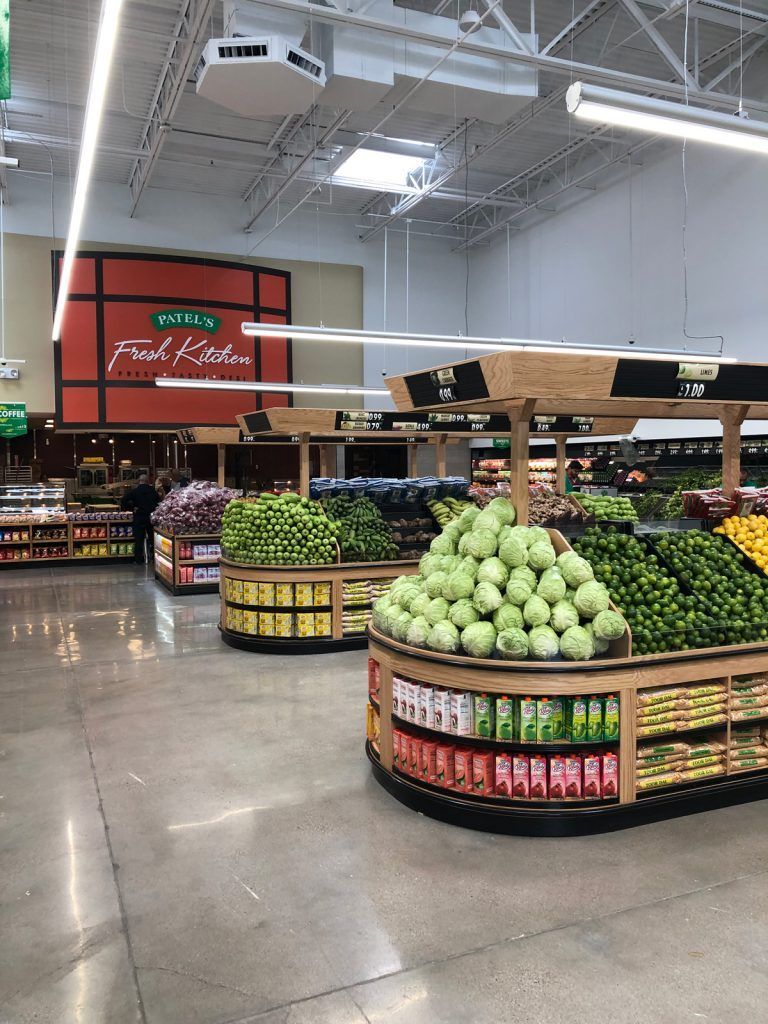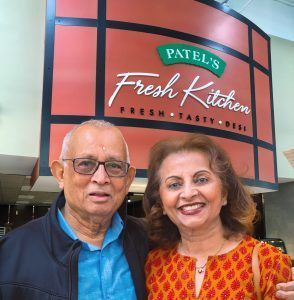In 1968, Mafat Patel headed for America in search of the American Dream. He was 23 and had just received a visa to pursue his MBA at Indiana University. Two years later, he graduated and left for Chicago, eventually settling into factory work on an assembly line. It was a sense of isolation and, as he would say later, appetite that pushed his life into a new direction.
After he noticed others longing for a taste of home, he decided he wanted to open a grocery store. As fate would have it, in 1971, a local businessman approached Mafat about a location on Devon Avenue. Knowing he could not do it alone, he reached out to his brother, Tulsi, who was still in Gujarat.
Working on the logistics of their plan, the Patel Brothers opened their first location in 1974 in the Little India area of the West Rogers Park neighborhood on Devon Avenue. The 900 square foot store, as small and disorganized as it was, provided a gateway to home, particularly the delicacies and atmosphere other stores lacked.
Today, with 52 locations across the country, Patel Brothers has become a model of grocery excellence, complete with online shopping capabilities and private label selections.
To get an inside look at the project and the Patel Brand, we sat down with Bryon Muir, Director of Business Development, at Knoebel Construction and Patel Brothers President Rakesh Patel.
Give us a snapshot of the Knoebel/Patel relationship.
Bryon Muir: Patel Brothers began in 1974 with the purchase by the two Patel Brothers of an existing grocery store on Devon Avenue in Chicago. Although successful with this store, they knew there was a need among the growing Indian community in America for flavors from home, so they started to source and produce packaged and fresh foods targeted to meet this need. This proved to be a major success and helped them grow.
Rakesh Patel: Knoebel Construction has multiple on-site project managers who know our criteria. They know exactly what we need and want, so they execute projects in many markets across the county on their own. They will reverse engineer plans to make the design more economical and save us money.

What type of demographic do you target?
Muir: Patel Brothers is a US-based grocery retail chain that focuses on flavors and foods found in the Indian sub-continent and the Middle East, and situates new stores as closely as possible to the communities they serve.
To do this means they sometimes need Knoebel to renovate and update an existing store in an inline strip, and at other times this requires we build a new store from the ground up. We’re happy to adjust our construction plan to meet whatever needs they have to reach their community.
What features are today’s consumers looking for?
Muir: They are looking for what they need conveniently accessible, at a price they can afford, and from a company they can respect and that knows respects them as a consumer. We know that Patel Brothers respects their consumers by the choices they make when developing the plans and directing our efforts during construction.
How does the overall design of the stores cater to today’s consumers?
Muir: We’ve been fortunate to watch the brand evolve and to see these changes in action over the course of our relationship. Our first store was roughly half of the footprint of today’s stores and did not have the newer amenities that shoppers expect at current Patel Brothers locations.
What kind of adjustments have you made to cater to how customers shop in this new landscape?
Patel: Customers want convenience and “hospital clean,” hygienic stores. In Naperville (Illinois), we have two employees who clean all day. They clean the bathrooms every 30 minutes. Our bathrooms are cleaner and better looking than they are at the Ritz Carlton.
Customers also want more spacious stores now. They don’t want big displays. They want more places to stand and walk. We have reduced shelf space to have more space in the store. We are adjusting our layout to be more spacious with 7 to 7 1/2-foot aisles.
“Customers want convenience and ‘hospital clean,’ hygienic stores. Our bathrooms are cleaner and better looking than at the Ritz Carlton.” — Rakesh Patel, President, Patel Brothers
Walk us through how and why the Patel locations are designed the way they are?
Muir: Patel Brothers is designed not only on the basis of customer convenience, but also with the ability to process a high volume of goods through the back of house and sales areas. Aisles are kept wide and doorways are oversized both for width and height for the ease of transferring pallets of goods.
New stores are also designed with the ability to transport pallets of goods directly from the back-of-house directly to consumers’ vehicles for high-demand products.
Take us through your construction and design strategy.
Muir: At Knoebel, we’re always putting the value of our relationship with our clients above a specific project’s profits. This means we’re always looking for ways to reduce costs, yet maintain the durability for the owner and still meet the expectations of the shopper. The stores have evolved to a more high-end look today than the earlier versions.
For example, restroom finishes have moved to more expensive tile, but these changes were also made to lower facility costs and the endurance of the finishes. We are not only trying to keep an eye on the construction costs today, but what can decrease costs for the owner in the long run.
What’s the biggest issue today related to the construction side of the business?
Muir: It would definitely be the pandemic’s impact on construction. These are numerous and, in some ways, surprising. We must still remain vigilant regarding our efforts to prevent the introduction and spread of the virus on our job sites.
Added to this now are the ripple effects of the pandemic on supply chains. Sourcing materials from overseas, especially China, has become fraught with delays, and it is well known that wood prices have severely spiked.
On top of this, the sudden release of pent up capital projects from last year has resulted in a run on manufactured steel building components, which has caused extreme lead-time issues that are now, in the case of steel joists, pushing them into months long waits.
Today, with 52 locations across the country, Patel Brothers has become a model of grocery excellence, complete with online shopping capabilities and private label selections.
Talk about sustainability. What are you doing?
Muir: Knoebel Construction has always pushed to complete our projects as lean as possible and not have excess waste. This is not only environmentally sound, but also impacts our profitability.
What type of opportunities do you see moving ahead?
Muir: Patel Brothers and all our grocery clients were negatively impacted by the pandemic and had to institute measures to help control the spread. Being essential businesses, they remained viable and open and are still a strong, growing sector. We anticipate to build and remodel several grocery locations this year, including some Patel Brothers’ locations.
What is Patel’s short-term strategy? Long-term?
Patel: To incorporate more fresh foods and food options. Thirty percent of our customer base are millennials. Ten years ago that number was 5%. The new generation doesn’t want to cook, but they do want fresh foods. Our Fresh Kitchen offers a selection of prepared Indian foods.
Our customers can buy individual ingredients, chopped vegetables ready to cook, freshly prepared refrigerated meals or fully cooked Indian cuisine. We will soon be hiring a corporate chef to create recipes.
A lot of people like Indian food. However, they may not want the experience of making it. We started offering half-prepared food two years ago. All the new stores offer it and we have been retrofitting existing locations as well. Our locations in smaller cities also have a dining area where customers can eat hot meals.
What’s the best piece of advice you can offer to other brands on how to deal with what’s happening right now?
Patel: Cater to the most vulnerable of your customers to keep them comfortable and everyone else will be taken care of automatically.
What’s the secret to creating a “must visit” location today?
Muir: We know we must not skimp on the details. We know our clients expect a high quality product from us that’s going to last a long time, but we also know their shoppers vote with their feet as well. They notice if the tile isn’t grouted well or if the painter didn’t do a good job.
They understand if the store isn’t built well it reflects on the products inside. The key is to sweat the small stuff and make sure the consumer experience is great from Day 1 to Day 1,001.
 One-on-One with…
One-on-One with…
Bryon Muir, Director of Business Development, Knoebel Construction
Describe a typical day.
A typical day is coordinating with superintendents in the morning on the daily plan and any immediate needs, followed typically with communications with our clients’ construction representatives to update them on the project status and coordinate any vendor deliveries or work.
Throughout the day there will be constant communication to coordinate subcontractor activities and to purchase any needed materials, or hire any remaining subcontractors needed for project completions.
What’s the biggest item on your to-do list?
To ensure we’re in good footing for the extreme volume of work that’s being released this year. We’re hiring new team members right now and making sure we’ve expanded systems in place to handle our increased workload.
What’s the most rewarding part of your job?
Getting to meet new clients and then, after completing a project, becoming a valued resource and partner to help with the expansion of their brands. It’s very satisfying to be considered, if not a friend, then a reliable partner to our clients.
What was the best advice you’ve ever received?
On a professional level, it was to view a project through the eyes of the client. We may not be told what the expectations are so we need to anticipate those expectations to meet them. This really only comes from experience, which is something as an organization celebrating 40 years in 2021 we have a lot of.
Best thing a client ever said to you?
“You get it.” This was from a very valued, yet demanding client who had a vision for his stores and had trouble expressing it. This could have caused friction during construction. It wasn’t the first store, or the second, but we kept trying, and he noticed we weren’t giving up on him or his vision.
Eventually, what started off as difficult builds became a partnership where we were not only able to complete projects successfully, but also to contribute and assist with brand change and growth.
Story by Michael J. Pallerino, editor of Commercial Construction & Renovation magazine. Over the past 30-plus years, he has won numerous awards, including the “Jesse H. Neal Editorial Achievement Award,” recognized as the Pulitzer Prize for business-to-business magazines. He can be reached at mikep@ccr-mag.com.












